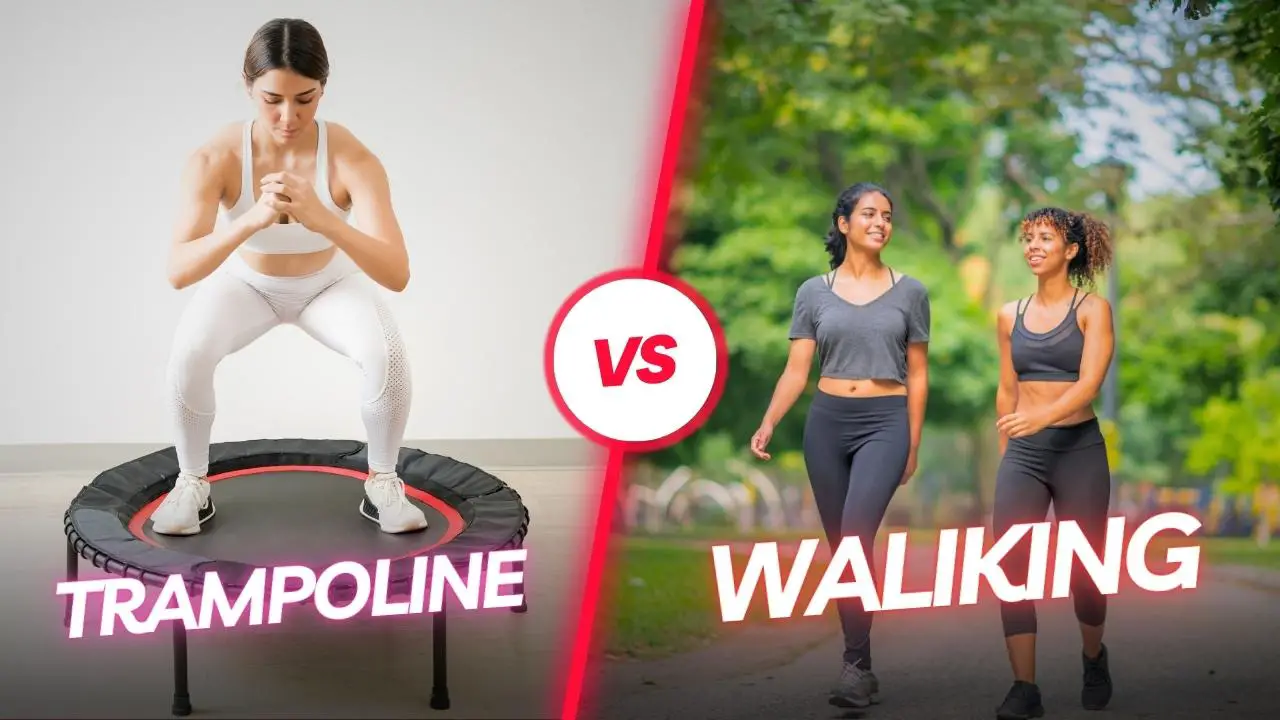Regarding physical exercise, countless options are available to individuals seeking to improve their health and fitness levels. Among these options, two popular choices are trampolining and walking. While both activities benefit the body and mind, they differ in intensity, impact, and overall experience.
Trampolining provides a dynamic and exhilarating workout with its bouncing and aerial maneuvers. It engages multiple muscle groups, enhances cardiovascular fitness, and improves coordination and balance.
On the other hand, walking is a low-impact activity that can be easily incorporated into daily routines. It offers a gentler exercise, suitable for individuals of various fitness levels while still providing cardiovascular benefits and promoting joint mobility.
In this comparison, we will explore the characteristics and benefits of trampolining and walking, exploring their unique contributions to physical fitness.
By understanding the advantages and considerations of each activity, individuals can make informed decisions about the exercise method that aligns best with their goals, preferences, and physical capabilities.
Whether bouncing on a trampoline or strolling along a scenic path, both options offer improved health and well-being pathways.
Trampoline vs Walking: Trampolining offers a dynamic and exhilarating workout, engaging multiple muscle groups. Conversely, walking is a low-impact activity suitable for various fitness levels, promoting cardiovascular health and joint mobility.
What is a Trampoline, and How it Works?

A trampoline is a recreational apparatus with a strong, flexible fabric stretched tightly over a steel frame with coiled springs. It is designed to enable individuals to bounce on its surface, providing a thrilling and enjoyable experience.
Trampolines are commonly found in outdoor recreational areas, gyms, and indoor entertainment centers.
The fundamental principle behind the operation of a trampoline lies in the potential energy stored within the springs. When a person jumps on the trampoline, their weight compresses the springs.
Subsequently, as they reach the lowest point of their jump, the springs release the stored energy, propelling the jumper into the air. This bouncing motion continues as long as the individual maintains their momentum.
Benefits of using a trampoline for exercise
Trampolining offers a range of benefits, making it an increasingly popular choice for exercise and fitness enthusiasts. Here are three key benefits of using a trampoline for exercise:
Cardiovascular benefits:
Jumping on a trampoline can provide an excellent cardiovascular workout. The repetitive bouncing motion engages significant muscle groups, including the legs, core, and arms, increasing the heart rate.
Regular cardiovascular exercise improves cardiovascular health, enhances stamina, and helps burn calories, leading to potential weight loss.
Improved balance and coordination:
Trampolining requires individuals to maintain balance and coordination while adjusting to the changing forces acting upon their bodies.
The continuous bouncing action challenges the body’s equilibrium and prompts the development of better balance and coordination skills over time.
This improvement in balance and coordination can positively affect daily activities and overall motor skills.
Increased muscle strength and endurance:
Jumping on a trampoline engages various muscle groups, particularly the lower body. The leg muscles, including the quadriceps, hamstrings, and calf muscles, work vigorously to propel the body upwards.
The core muscles, such as the abdominal and back muscles, are continuously engaged to maintain stability during the bouncing motion. Regular trampoline exercise can increase muscle strength and endurance in these areas.
Highlighting potential risks or precautions associated with trampoline use
While trampolines offer numerous health benefits, it is essential to acknowledge and address the potential risks related to their use. By adhering to safety guidelines and taking necessary precautions, individuals can minimize the likelihood of injuries. Here are two key aspects to consider:
Safety guidelines:
Following established safety guidelines is crucial when using a trampoline. These guidelines often include recommendations such as:
- Setting up the trampoline on a flat surface away from obstacles and overhead obstructions.
- Use safety padding to cover the springs, frame, and surrounding areas to minimize the risk of impact injuries.
- Limiting the number of users to avoid collisions reduces the risk of falls.
- Supervise children while using the trampoline to ensure they follow safety rules and guidelines.
Injury risks and prevention measures:
Trampolining, like any physical activity, carries the risk of injuries. Some common injuries associated with trampoline use include sprains, fractures, and head injuries. To mitigate these risks, it is essential to take preventive measures:
- Start with a proper warm-up to prepare the body for physical activity and reduce the risk of muscle strains.
- Avoid attempting complex or high-risk maneuvers without proper training or supervision.
- Use the trampoline within one’s skill and comfort level, gradually progressing to more challenging exercises.
- Always land with control, keeping the knees slightly bent to absorb the impact.
- Consider using safety equipment such as a safety net enclosure to prevent falls from the trampoline surface.
Walking as a form of exercise

Walking is a form of exercise that involves the rhythmic movement of the legs, propelling the body forward in an upright position.
It is a low-impact aerobic activity suitable for people of all ages and fitness levels. With minimal equipment required, walking can be done almost anywhere. It offers numerous physical and mental health benefits.
Regular walking improves cardiovascular fitness, lowers blood pressure, and helps manage weight. It also strengthens muscles, especially in the legs and core. Walking serves as a natural stress reliever, reducing anxiety and depression symptoms.
It enhances mood and mental well-being, mainly outdoors in natural settings. Walking is an accessible and effective exercise that promotes overall health and fitness.
Advantages of walking for overall health and fitness
Walking offers numerous advantages for overall health and wellness. Here are some advantages of walking:
Low Impact:
Walking is a low-impact exercise that puts minimal stress on your joints, making it suitable for people of all fitness levels and ages. It is gentle on the knees, hips, and ankles, reducing the risk of injury compared to high-impact activities.
Cardiovascular Health:
Walking regularly can improve cardiovascular fitness. It increases heart rate, strengthens the heart muscle, and improves blood circulation, lowering the risk of heart disease, stroke, and high blood pressure.
Weight Management:
Walking can be an effective tool for weight management. It helps burn calories, especially when combined with a healthy diet, aiding in weight loss or weight maintenance. It is a sustainable activity that can be incorporated into daily routines.
Mental Well-being:
Walking has numerous mental health benefits. It releases endorphins, which boost mood and reduce stress, anxiety, and symptoms of depression. Walking outdoors in nature can provide a calming and rejuvenating effect on the mind.
Bone Health:
Weight-bearing exercises like walking help strengthen bones and reduce the risk of osteoporosis. It stimulates bone growth and can improve bone density, especially when combined with a balanced diet rich in calcium and vitamin D.
Joint Mobility and Flexibility:
Walking helps maintain joint mobility and flexibility. It lubricates the joints, strengthens the surrounding muscles, and reduces the risk of joint stiffness or conditions like arthritis.
Improved Sleep:
Regular physical activity, such as walking, can promote better sleep quality. It can help regulate sleep patterns, enhance relaxation, and reduce insomnia symptoms.
Social Interaction:
Walking can be a social activity, providing an opportunity to connect with friends, family, or walking groups. Social interaction while walking can boost mood, motivation, and accountability.
Remember to start with a comfortable pace and gradually increase the duration and intensity of your walks. As health guidelines recommend, aim for at least 150 minutes of moderate-intensity walking or 75 minutes of vigorous-intensity walking per week.
Enjoy the benefits of walking while exploring new environments, listening to music or podcasts, or enjoying some quiet time.
Different ways to incorporate walking into a fitness routine
There are several ways to incorporate walking into a fitness routine to maximize its benefits. Here are a few ideas:
Brisk Walking:

Increase the intensity of your walks by picking up the pace. Aim to walk at a fast speed that raises your heart rate and makes you slightly breathless.
This helps improve cardiovascular fitness and calorie burning.
Interval Training:
Alternate between periods of brisk walking and faster-paced intervals. For example, walk at a moderate pace for a few minutes, then increase your speed to a fast walk or even a jog for a short duration. Repeat this cycle throughout your walk to challenge your cardiovascular system and boost calorie burn.
Hill Walking:

Find routes that incorporate uphill sections or stairs. Walking uphill adds resistance and engages different muscle groups, providing a more intense workout.
It helps build strength and endurance while burning additional calories.
Long Walks:
Set aside dedicated time for longer walks, such as on weekends or during days off. These walks can be more leisurely and allow you to explore new areas or nature trails. Longer walks enhance endurance, increase calorie expenditure, and offer mental relaxation.
Incorporate Strength Exercises:
Integrate strength exercises into your walking routine. Pause regularly to perform exercises like lunges, squats, or push-ups. These exercises complement walking by targeting additional muscle groups and enhancing overall body strength.
Walking Meetings or Socializing:
Suggest walking together instead of sitting for meetings or catching up with friends. It promotes productivity, social interaction, and physical activity simultaneously.
Technology and Challenges:
Utilize fitness trackers or smartphone apps to track your steps, distance, and progress. Set daily or weekly step goals and challenge yourself to achieve them. Compete with friends or join virtual walking challenges to stay motivated and engaged.
Remember to start at a comfortable level and gradually increase the intensity or duration of your walks. Listen to your body, wear comfortable shoes, and consider consulting with a healthcare professional before starting any new fitness routine.
Trampoline vs Walking: Comprehensive Comparison
Trampoline and walking are both physical activities that offer different benefits and considerations. Here’s a comparison between the two:
Impact on Cardiovascular Health
Trampolining: Trampolining can provide a moderate cardiovascular workout, especially when performed with intensity and for an extended duration. The bouncing motion on a trampoline elevates the heart rate and promotes blood circulation, contributing to cardiovascular health.
However, the intensity of the cardiovascular exercise on a trampoline may vary depending on factors such as the user’s effort, the duration of the session, and the specific trampoline exercises performed.
Walking: Walking is a low-impact aerobic exercise that offers numerous cardiovascular benefits. Brisk walking raises the heart rate, increases oxygen intake, and improves blood circulation.
Regular walking can improve cardiovascular endurance, lower blood pressure, reduce the risk of heart disease, and promote overall cardiovascular health.
Unlike trampolining, the intensity of walking can be easily adjusted by altering the speed, incline, or distance.
In terms of cardiovascular health, both trampolining and walking can be beneficial. However, walking provides greater flexibility in adjusting the intensity of the exercise, making it suitable for individuals of all fitness levels.
Impact on Muscle Groups and Body Toning

Trampolining: Trampolining engages various muscle groups throughout the body. The bouncing motion primarily activates the leg muscles, including the quadriceps, hamstrings, and calves, as they work to propel the body upward.
The core muscles are continuously engaged to maintain stability and control, while the arm muscles can be further exercised by incorporating arm movements. Trampolining provides a balanced workout that can lead to improved muscle tone and overall body conditioning.
Walking: Walking primarily engages the leg muscles, including the calves, quadriceps, and hamstrings. It also activates the glutes and core muscles to provide stability and support during each step.
Although walking does not provide the same level of muscle activation as trampolining, it still offers a low-impact workout that can contribute to overall muscle toning and endurance, particularly in the lower body.
Both trampolining and walking provide muscle toning benefits, but trampolining offers a more comprehensive engagement of muscle groups due to the dynamic bouncing motion.
Calorie-Burning Potential
Trampolining: Trampolining can be an effective calorie-burning activity. Multiple muscle groups’ continuous bouncing and engagement elevate the heart rate, increasing calorie expenditure.
The number of calories burned during trampolining depends on factors such as body weight, the intensity of the bouncing, and the session duration. On average, trampolining can burn approximately 200-300 calories per 30 minutes, making it a moderate-intensity calorie-burning exercise.
Walking: Walking is a low-impact exercise that can still contribute to calorie burning. The number of calories burned during a walk depends on body weight, walking speed, and distance covered.
Walking can average burn approximately 120-180 calories per 30 minutes, depending on the intensity. However, this can vary significantly based on individual factors.
Trampolining generally offers a higher calorie-burning potential than walking due to increased intensity and engagement of multiple muscle groups. However, the actual calorie expenditure will depend on the individual’s effort and the duration of the activity.
Impact on Joint Health and Injury Risks
Trampolining: Trampolining, if performed without proper technique and safety precautions, can pose a risk of joint injuries, particularly to the ankles, knees, and spine. The repetitive bouncing motion can place stress on joints, and landing improperly may result in sprains, strains, or more severe injuries.
Using a trampoline with safety features such as padding, a sturdy frame, and proper supervision is essential. Individuals with pre-existing joint issues or injuries should consult a healthcare professional before trampolining.
Walking: Walking is a low-impact exercise that places minimal stress on the joints, making it suitable for people with joint issues or those recovering from injuries. It is a safe activity that can help improve joint mobility and flexibility.
However, it is essential to wear appropriate footwear, maintain proper posture, and gradually increase intensity or distance to avoid overuse injuries.
Regarding joint health and injury risks, walking is generally considered a safer option than trampolining, especially for individuals with common issues or those prone to injuries.
Cost and Space Requirements
Trampolining: Trampolines can vary in cost depending on the size, quality, and features. They require a dedicated space, preferably outdoors, with sufficient clearance around the trampoline for safe bouncing.
Trampolines come in various sizes, from compact ones suitable for single users to larger ones that can accommodate multiple users simultaneously.
Walking: Walking requires minimal equipment and can be done almost anywhere. A comfortable pair of walking shoes is the primary investment.
Walking outdoors, in parks, neighborhoods, or on dedicated walking paths. It can also be done indoors on a treadmill, which requires additional space and equipment.
Walking is more cost-effective and space-efficient than trampolining, as it does not require specialized equipment or dedicated space.
Safety Considerations for Trampolining and Walking
Safety considerations are essential for both trampolining and walking to ensure a safe and enjoyable exercise experience. When using a trampoline, always have supervision, especially for children and beginners, to prevent accidents.
Stick to one person using the trampoline at a time to avoid collisions, and educate users about safe jumping techniques, discouraging risky stunts or flips.
Installing safety enclosures or nets around the trampoline can prevent falls, and it’s crucial to follow the age and weight limitations specified by the manufacturer. Regularly inspect the trampoline for wear and tear, and keep it in an open area away from potential hazards.
While walking, wear appropriate footwear for comfort and support, and adhere to traffic rules and pedestrian crossings. Choose well-lit areas for walking at night and be cautious of uneven surfaces. If there are no sidewalks, walk facing traffic to see approaching vehicles.
It’s essential to stay hydrated, warm up before exercise, and cool down afterward. Walk with others in unfamiliar or secluded areas, and carry identification and emergency contact information.
Consult with a healthcare professional before starting any exercise routine, especially if you have pre-existing health conditions.
By following these safety tips, individuals can enjoy the benefits of trampolining and walking while minimizing the risk of injuries and promoting overall well-being.
Which is Better: Trampoline or Walking?
Trampoline exercise is more beneficial for seniors than walking. Simply put, if we consider a person weighing 150 pounds, the pressure exerted on their joints while walking, which is about 570 pounds, is reduced to only 97 pounds when using a mini-trampoline. Rebounding, or exercising on a trampoline, is a fantastic workout.
Related Article: What is a Standard Size Trampoline
FAQs
Q1: Which activity is better for cardiovascular fitness: trampolining or walking?
Both trampolining and walking offer cardiovascular benefits, but trampolining provides a higher-intensity workout that can elevate the heart rate more effectively. Walking is a lower-impact activity suitable for individuals of various fitness levels.
Q2: Can trampolining help with weight loss more than walking?
Trampolining generally burns more calories per minute than walking, making it a potentially more effective activity for weight loss. However, the actual calorie burn depends on factors such as intensity, duration, and individual characteristics.
Q3: Is trampolining suitable for individuals with joint problems?
Trampolining is a higher-impact activity that may not be recommended for individuals with existing joint issues. It is advisable to consult with a healthcare professional before engaging in trampolining if you have joint problems.
Q4: Does walking have any impact on muscle strength and tone?
Walking primarily targets the lower body muscles and can help strengthen and tone the calves, quadriceps, and glutes. While it may not provide as significant muscle engagement as trampolining, regular walking can still contribute to muscle strength and endurance.
Q5: Are there any age restrictions for trampolining and walking?
People of various ages can enjoy trampolining, but following safety guidelines and considering the individual’s physical capabilities is important. On the other hand, walking is a low-impact activity suitable for individuals of all ages, including older adults.
Q6: Can trampolining improve balance and coordination?
Trampolining requires maintaining balance and coordination to adjust to the bouncing motion. Regular trampolining can contribute to improved balance and coordination skills over time.
Q7: Are there any specific precautions to take while trampolining or walking?
For trampolining, it is essential to follow safety guidelines, use appropriate padding and safety features, and avoid attempting high-risk maneuvers without proper training or supervision. It is advisable to wear comfortable footwear, choose suitable walking surfaces, and gradually increase the intensity to avoid overexertion.
Conclusion:
In conclusion, when comparing trampolining and walking as exercise options, they have unique benefits and considerations. Trampolining provides cardiovascular benefits by elevating heart rate and increasing blood flow. It also improves balance, coordination, and muscle strength.
However, trampoline use requires adherence to safety guidelines and precautions to minimize injury risks. On the other hand, walking offers numerous advantages for overall health and fitness.
It is a low-impact exercise that promotes cardiovascular health, weight management, mental well-being, bone health, joint mobility, flexibility, and improved sleep.
Additionally, walking allows for social interaction and can be incorporated into various fitness routines through brisk walking, interval training, hill walking, long walks, and strength exercises. While trampolining may have a higher calorie-burning potential, walking is a more accessible and cost-effective option that requires less space.
Ultimately, the choice between trampolining and walking depends on individual preferences, fitness goals, and the availability of resources.
We hope you understand the topic well after reading this detailed guide comparing trampolines and walking. If you have any questions, please feel free to comment below!

